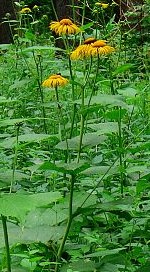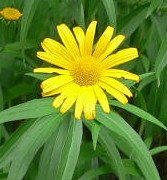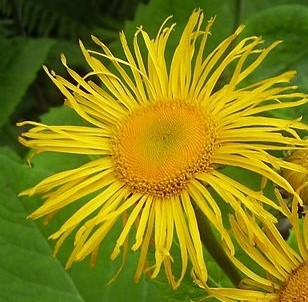 Buphthalmum are a genus in the aster family, Asteraceae, that also includes goldenrod, daisies and lettuce. It includes two cultivated species, both clump-forming herbaceous perennials native to southeastern Europe. Their flowerheads consist of yellow ray flowers surrounding yellow disc flowers and subtended by narrow phyllaries. The leaves are alternate, dark green and toothed. Plants can be propagated by seed or division in the spring. They do well in zones 3-7 in average to lean, moist soil. The genus name Buphthalmum comes from the Greek words bos meaning ox and opthalmos meaning eye, in reference to the supposed resemblance of the flower to the eye of an ox, the source of the common name, oxeye. Flowers are suitable for the vase.
Buphthalmum are a genus in the aster family, Asteraceae, that also includes goldenrod, daisies and lettuce. It includes two cultivated species, both clump-forming herbaceous perennials native to southeastern Europe. Their flowerheads consist of yellow ray flowers surrounding yellow disc flowers and subtended by narrow phyllaries. The leaves are alternate, dark green and toothed. Plants can be propagated by seed or division in the spring. They do well in zones 3-7 in average to lean, moist soil. The genus name Buphthalmum comes from the Greek words bos meaning ox and opthalmos meaning eye, in reference to the supposed resemblance of the flower to the eye of an ox, the source of the common name, oxeye. Flowers are suitable for the vase.
Willowleaf Oxeye (B. salicifolium)
 With long narrow unscented leaves resembling those of a weeping willow, this oxeye bears solitary, terminal yellow flowerheads two inches across in late summer. Deadhead to prolong bloom. The stems are erect but slender and plants need staking. The species name, salicifolium, comes from the Latin words Salix, the name for willow, and folia meaning leaf, and refers to the willow-like appearance of the foliage.
With long narrow unscented leaves resembling those of a weeping willow, this oxeye bears solitary, terminal yellow flowerheads two inches across in late summer. Deadhead to prolong bloom. The stems are erect but slender and plants need staking. The species name, salicifolium, comes from the Latin words Salix, the name for willow, and folia meaning leaf, and refers to the willow-like appearance of the foliage.
Size: 1-2’ H x 2” W
Bloom time: Late summer
Light: Full sun
Scented Oxeye (B. speciosum aka Telekia speciosus)
 The large heart shaped basal leaves and tall stature of the plant recommend it for the back of the border where it will flower for a long bloom time. The basal leaves are up to eight inches long, lightly hairy beneath, and aromatic; the stem leaves are smaller, oval, and sessile. The flowerheads are produced in sprays and are up to three inches across with yellow ray flowers surrounding orange disc flowers. The species name, speciosus,comes from the Latin word meaning showy.
The large heart shaped basal leaves and tall stature of the plant recommend it for the back of the border where it will flower for a long bloom time. The basal leaves are up to eight inches long, lightly hairy beneath, and aromatic; the stem leaves are smaller, oval, and sessile. The flowerheads are produced in sprays and are up to three inches across with yellow ray flowers surrounding orange disc flowers. The species name, speciosus,comes from the Latin word meaning showy.
Size: 4-5’ H x 3” W
Bloom Time: Late summer
Light: Part shade; tolerates full sun if soil consistently moist.